
In this real world word problem students must graph linear equations.
- Subject:
- Mathematics
- Material Type:
- Activity/Lab
- Provider:
- Illustrative Mathematics
- Provider Set:
- Illustrative Mathematics
- Author:
- Illustrative Mathematics
- Date Added:
- 05/01/2012

In this real world word problem students must graph linear equations.

Beavers are generally known as the engineers of the animal world. In fact the beaver is MIT's mascot! But honeybees might be better engineers than beavers! And in this lesson involving geometry in interesting ways, you'll see why! Honeybees, over time, have optimized the design of their beehives. Mathematicians can do no better. In this lesson, students will learn how to find the areas of shapes (triangles, squares, hexagons) in terms of the radius of a circle drawn inside of these shapes. They will also learn to compare those shapes to see which one is the most efficient for beehives. This lesson also discusses the three-dimensional shape of the honeycomb and shows how bees have optimized that in multiple dimensions. During classroom breaks, students will do active learning around the mathematics involved in this engineering expertise of honeybees. Students should be conversant in geometry, and a little calculus and differential equations would help, but not mandatory.
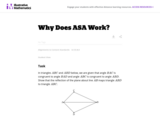
The two triangles in this problem share a side so that only one rigid transformation is required to exhibit the congruence between them. In general more transformations are required and the "Why does SSS work?'' and "Why does SAS work?'' problems show how this works.
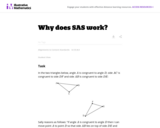
For these particular triangles, three reflections were necessary to express how to move from ABC to DEF. Sometimes, however, one reflection or two reflections will suffice. Since any rigid motion will take triangle ABC to a congruent triangle DEF, this shows the remarkable fact that any rigid motion of the plane can be expressed as one reflection, a composition of two reflections, or a composition of three reflections.
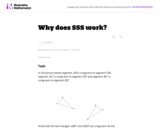
This particular sequence of transformations which exhibits a congruency between triangles ABC and DEF used one translation, one rotation, and one reflection. There are many other ways in which to exhibit the congruency and students and teachers are encouraged to explore the different possibilities.

This lesson is an introduction to Multiple Regression Analysis or MRA, a statistical process used widely in many professions to estimate the relationship among variables. The aim of this video is to make it easier for students to understand the introduction to the concept of MRA based upon a property valuation setting. In order to facilitate students’ understanding of this, a scaffolding method is used whereby students are first exposed to basic equations. Then they will be introduced to the concept of variables, teaching them to calculate property value based on only 2 variables. Their understanding is further enhanced by exposing them to multiple variables related to property valuation. Finally, they are asked to calculate property value based on multiple variables. It is shown in this video that finding the value of two variables is possible using the paired comparison method, but that the same method cannot be applied if we have more than 2 equations; that is when Multiple Regression Analysis is needed. MRA can solve problems related to more than 2 equations. A prerequisite for students is an understanding of basic statistics such as total, average, mod, mean and median.
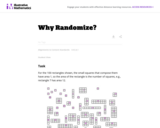
This exercise demonstrates that judgment (non-random) samples tend to be biased in the sense that they produce samples that are not balanced with respect to the population characteristics of interest.

The purpose of this task is to assess (1) ability to distinguish between an observational study and an experiment and (2) understanding of the role of raandom assingment to experimental groups in an experiment.
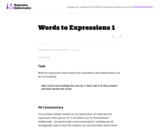
This problem allows students to see words that can describe the expression. Additionally , the words (add, sum) and (product, multiply) are all strategically used so that the student can see that these words have related meanings.

A Khan Academy module that offers instruction and practice problems in exponents and scientific notation.

This project will raise student awareness of the problem of waste and waste management in our community. As we progress through the unit the goal is to reduce the amount of waste that our school produces. There are many ways to do this but the most unique aspect is to reduce biodegradable waste from our cafeteria through the process of vermicomposting. Students will design and create worm bins to reduce our cafeteria waste. The project will take a couple of weeks for the content and the construction of worm bins and then we will monitor our worm bins throughout the school year.
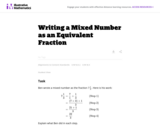
The purpose of this task is to help students understand and articulate the reasons for the steps in the usual algorithm for converting a mixed number into an equivalent fraction.
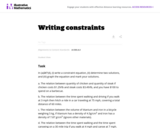
The purpose of this task is to give students practice writing a constraint equation for a given context. Instruction accompanying this task should introduce the notion of a constraint equation as an equation governing the possible values of the variables in question.
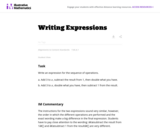
The instructions for the two expressions sound very similar, however, the order in which the different operations are performed and the exact wording make a big difference in the final expression. Students have to pay close attention to the wording: Ňsubtract the result from 1Ó and Ňsubtract 1 from the resultÓ are very different.

This short video and interactive assessment activity is designed to teach second graders an overview of money.

The purpose of this task is to give students practice interpreting statements using function notation. It can be used as a diagnostic if students seem to be having trouble with function notation, for example interpreting f(x) as the product of f and x.
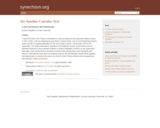
I intend this book to be, firstly, a introduction to calculus based on the hyperreal number system. In other words, I will use infinitesimal and infinite numbers freely. Just as most beginning calculus books provide no logical justification for the real number system, I will provide none for the hyperreals. The reader interested in questions of foundations should consult books such as Abraham Robinson's Non-standard Analysis or Robert Goldblatt's Lectures on the Hyperreals. Secondly, I have aimed the text primarily at readers who already have some familiarity with calculus. Although the book does not explicitly assume any prerequisites beyond basic algebra and trigonometry, in practice the pace is too fast for most of those without some acquaintance with the basic notions of calculus.

This version of YAINTT has a particular emphasis on connections to cryptology. The cryptologic material appears in Chapter 4 and §§5.5 and 5.6, arising naturally (I hope) out of the ambient number theory. The main cryptologic applications – being the RSA cryptosystem, Diffie-Hellman key exchange, and the ElGamal cryptosystem – come out so naturally from considerations of Euler’s Theorem, primitive roots, and indices that it renders quite ironic G.H. Hardy’s assertion [Har05] of the purity and eternal inapplicability of number theory. Note, however, that once we broach the subject of these cryptologic algorithms, we take the time to make careful definitions for many cryptological concepts and to develop some related ideas of cryptology which have much more tenuous connections to the topic of number theory. This material therefore has something of a different flavor from the rest of the text – as is true of all scholarly work in cryptology (indeed, perhaps in all of computer science), which is clearly a discipline with a different culture from that of “pure”mathematics. Obviously, these sections could be skipped by an uninterested reader, or remixed away by an instructor for her own particular class approach.

Students will have to solve the real world problem of locker smell leakage by building an air filter that will cover the vents on the top of a locker. This project goes well with a curriculum on the particle nature of gases and phase changes.

This is a simple task touching on two key points of functions. First, there is the idea that not all functions have real numbers as domain and range values. Second, the task addresses the issue of when a function admits an inverse, and the process of "restricting the domain" in order to achieve an invertible function.